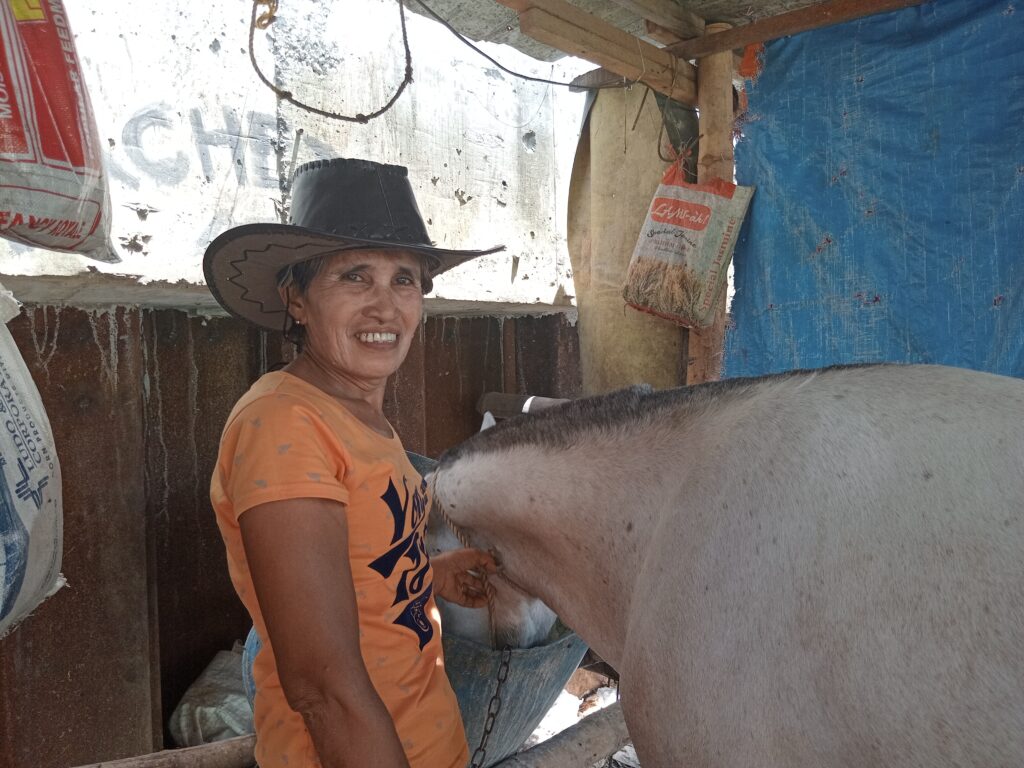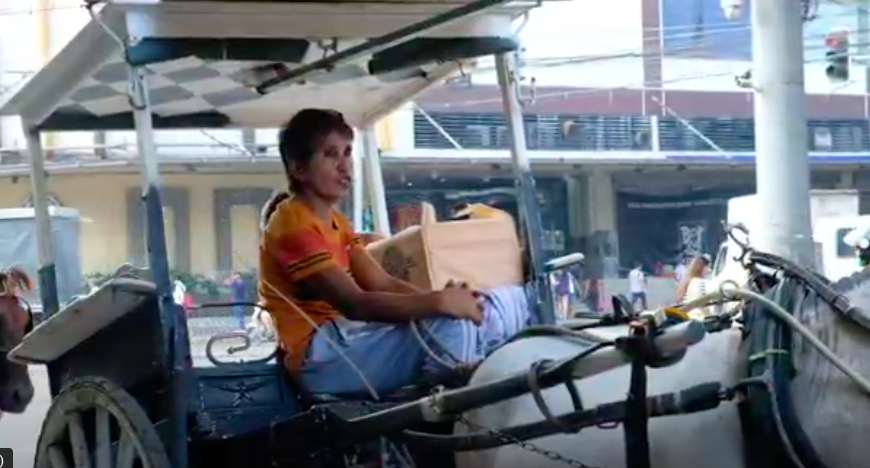
Julieta Gempisao and her horse, Covid. | Photo by Resha Kaye Sarita
CEBU CITY, Philippines – Cebu City has always been known for its richness in culture and heritage.
And in this modern day and age, we continue to see horse-drawn carriages, locally known as tartanilla, that continue to ply downtown roads.
These tartanillas are driven mostly by male kutseros.
But do you know that in this industry dominated by men, there also exists a woman who is trying to make a living for her family?
Meet Julieta Gempisao, a female kutsero from Barangay Duljo Fatima in Cebu City.
Gempisao, 59, has been offering tartanilla rides for 30 years now. To date, she is the only remaining female kutsero in the city as the other one has already retired.
She admits that her chosen profession was not easy but she enjoys what she does. At the same time, it also allows her to support the needs of her family.
“Proud kay ko sa akong pagkababae. Kung gustohan nako unsay buhaton nga mabuhat nako, mabuhat nako. Ipakita na strong ko. Babae ko. (I am proud of being a woman. If I want to do something, I can always do it. I am able to show that I am strong. I am a woman.),” she said.
Gempisao is a widow. Her husband, Emanuelle, died in 2018 due to hypertension.
Since his death, Gempisao had assumed the responsibility of being a mother and father to her children Mary Fe, 43; Jayme, 41; Joseph, 39; Jason, 33; Lloyd Vincent, 26; Joshua, 20; and Kith Bradley, 17.

Dempisao wait for passengers in downtown Cebu City. | Grabbed from the video of Resha Kaye Sarita
Taking a ride with papa
Gempisao said she already had her passion for horses even before she met her husband.
Her father, Antonio Fernandez, was also a kutsero. When she was little, she would ride with her papa during his “pamasada” (trips). It was also Fernandez who taught her the secrets of the trade.
Shortly after she married Emanuelle in September 1985, Gempisao decided to work as a kutsero. She was in her early twenties then.
“Nangutsero ko kay para abag sa akong bana. (I decided to be a kutsero to help my husband.), ” she said.
READ: Kutseros in Cebu City: ‘Naa pa mi basta naa pay gusto nga mosakay namo’
Before the pandemic hit, she would normally earn at least P700 per day, which was already enough to support the needs of her children. Her earnings dropped when Covid-19 lockdowns were implemented.
Gempisao said that she had been working very hard since her husband died because of the need to pay their bills, bring food to their table and ensure the maintenance of her horse, whom she named Covid.
Making sacrifices
Juggling her responsibilities as a breadwinner, mother, and kutsero was never easy.
Gempisao had to wake up early at around early 6 a.m. to attend to Covid’s needs. She would bath and feed her horse with bran and chopped hay.
She then collects horse manure to dry in the sun and sells these for fertilizer. After her work with her horse was done, she would then do some household chores. And shortly before noontime, Gempisao starts to prepare for her work.
Gempisao said she was out on the streets when there was sunny weather and even when it rains.
When she finally comes home at 8 p.m. she is already too exhausted and she could feel her body ache. But she would still prefer to wake up early the next day and continue with her tasks.
She also takes comfort knowing that the other kutseros respect and consider her as an equal in their male dominated world.

Gempisao said she is happy with her work as a kutsero. | Photo by Resha Kaye Sarita
Taking pride in her work
Gempisao said she takes pride in her work. She also finds fulfillment in the fact that she was able to take care of her children and her fifteen grandchildren despite her meager income.
To date, most of her children are already married and have families of their own. She shares her shanty with two of her younger boys who are still in school. Joshua is now Grade 11 while her youngest, Kith, is Grade 9. Both are enrolled at Don Carlos A. Gothong Memorial National High School.
Gempisao recalled that there was a time when her children asked her to already stop from working as a kutsero and instead find a job that was suitable for a woman like her.
But she chose to be with her horse.
She said she was lucky that her children and grandchildren understood and supported her decision.
“Malipay ko oy nga murag maghilak bitaw ko sa kalipay nga ay ingon ana diay ang sakripisyo nako, nga sa gagmay pa ilang mama, unya karon nga nadako na, nga naay apo nga proud kay sa ilang Lola (I feel very happy and I’m always teary-eyed thinking that the sacrifices that I made when my children were still young paid off and I now have grandchildren who are also proud of their grandmother.),” she said.
A mother to other kutseros
Nicolas Miro, 26, said he was grateful for Gempisao, who was like a mother to him and the other kutseros they work with.
A kutsero for seven years, Nicolas said that Gempisao was always ready to lend a helping hand. She would help feed their other horses in the morning while he and the other kutseros in their area were still out on the streets to transport passengers.
These horses are reserved for their afternoon trips to allow the horses that they use in the morning to rest later in the day.
Nicolas and his brother Joshua, a kutsero for five years now, are Gempisao’s neighbors in Barangay Duljo Fatima.
And just like a real family, Gempisao would also come to them to ask for help or if she wanted to talk about something, Nicolas said.
RELATED STORIES
Tartanilla Cebu’s fading chariots
Tartanillas Kutseros brave the streets of Cebu City
/dcb
